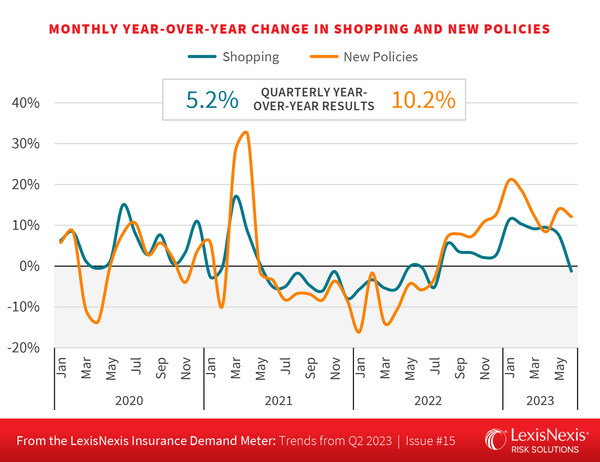Quarterly year-over-year auto insurance shopping growth in the U.S. was +5.2 percent in Q2 2023, according to the most recent LexisNexis Risk Solutions Insurance Demand Meter report.
Reacting to widespread rate increases by auto insurers, customers are comparison shopping for the best rate and coverage.
Although year-over-year shopping growth remains high, new business volumes began to outpace shopping last quarter, the report found, signaling that consumers are finding policies to suit their individual needs.
Quarterly year-over-year new policy growth – the rate at which consumers either switched or purchased new coverage – was strong at +10.2 percent.

“Profitability is still a challenge for many insurers, driven in large part by a continued rise in claims severity across the market associated with rising costs to repair damaged vehicles,” said Adam Pichon, senior vice president of auto insurance and claims at LexisNexis Risk Solutions. “As a result, most carriers are being much more discerning in their underwriting processes and cutting back on marketing spend, but motivated shoppers still sought better cost savings, and switched their policies in record numbers in May and June.”
“Increased claims severity has continued to challenge the U.S. auto insurance market, registering six consecutive quarters of at least 5 percent growth,” the analysis found.
Labor and part shortages have negatively impacted the cost to repair or replace vehicles.
The report noted that more than a quarter of collision events from 2022 (27 percent) were total losses adding to expense pressure.
Insurers are increasing rates and reducing marketing spend, while some larger carriers have pulled out of high-risk markets altogether.
“It’s a tough situation. Inflationary pressure on repair costs is creating more total losses on top of the added costs to those vehicles that can be repaired – and our data continues to suggest that consumers are shopping near claims events,” said Chris Rice, associate vice president of insurance strategic business intelligence, LexisNexis Risk Solutions. “When you combine these macroeconomic factors with claims and injury severities soaring, a lot of insurers have taken a step back to reassess how they will manage risk across their books of business for the foreseeable future.”
While new policy volumes continue to rise, U.S. auto policies’ in-force growth has slowed below traditional averages, the report stated.
The Insurance Demand Meter report suggests “the largest cause of this discrepancy is linked to household consolidation as more drivers, such as adult children moving back in with parents or relatives to save money or take on additional responsibilities for the household, are being added to existing policies”.
Analysis revealed as many as 2.4 million fewer policies in the market over the second quarter due to household consolidation.
Pichon suggests the property insurance market may follow the auto insurance market’s lead in raising rates.
“We indicated in previous editions of the Demand Meter that there would be an opening for opportunistic shoppers to find cost savings when shopping for auto insurance this year, and that was certainly the case,” said Pichon. “But how long can certain carriers that have been slower to take rate afford not to do so at the scale of some of their competitors? Now, we are seeing some similar rate-taking activity on the property insurance side of the equation, which could be another key factor that drives shopping over the remainder of the year.”
“A lot of carriers are gearing up for the next round of rate increases,” continued Pichon. “How consumers respond with respect to shopping in Q3, including how many more might exit the market, should give us a pretty good look at what 2024 may hold.”




















 Businesses Threatened by Rising Cyber Attacks
Businesses Threatened by Rising Cyber Attacks  As Wildfire Risk Grows, States Grapple to Retain Property Insurers
As Wildfire Risk Grows, States Grapple to Retain Property Insurers  Seeking Shelter From Mounting Hailstorms? New Approaches for Underwriters and Claims Execs
Seeking Shelter From Mounting Hailstorms? New Approaches for Underwriters and Claims Execs  Personal Auto Insurance Competition Heating Up, Root Execs Say
Personal Auto Insurance Competition Heating Up, Root Execs Say 



